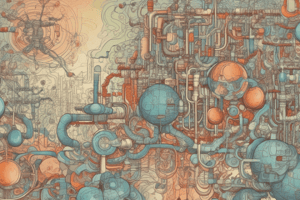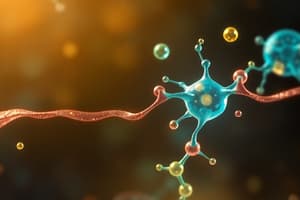Podcast
Questions and Answers
What type of receptor does epinephrine act on to produce tachycardia?
What type of receptor does epinephrine act on to produce tachycardia?
- Sensory receptor
- Ionotropic receptor
- Metabotropic receptor (correct)
- Olfactory receptor
Which of the following is NOT a criterion for physiological receptors?
Which of the following is NOT a criterion for physiological receptors?
- Reversible ligand binding
- Saturable ligand binding
- Irreversible ligand binding (correct)
- Tissue selectivity
What type of interactions are involved in weak and reversible binding of physiological ligands and drugs to receptors?
What type of interactions are involved in weak and reversible binding of physiological ligands and drugs to receptors?
- Metallic bonds
- Ionic bonds
- Covalent bonds
- Hydrogen bonds (correct)
What effect does increasing the number of productive interactions have on ligand-receptor binding affinity?
What effect does increasing the number of productive interactions have on ligand-receptor binding affinity?
What is the function of spare receptors in some systems?
What is the function of spare receptors in some systems?
In myasthenia gravis, what happens to over 80% of receptors in symptomatic patients?
In myasthenia gravis, what happens to over 80% of receptors in symptomatic patients?
What does activation of only 1% of Acetylcholine Receptors (AChR) at the neuromuscular junction produce?
What does activation of only 1% of Acetylcholine Receptors (AChR) at the neuromuscular junction produce?
'Structural specificity (hand in glove)' refers to receptors being able to distinguish between what?
'Structural specificity (hand in glove)' refers to receptors being able to distinguish between what?
'Response is a Function of Receptor Occupancy' states that a maximum response can be achieved with less than 100% receptor occupancy due to what?
'Response is a Function of Receptor Occupancy' states that a maximum response can be achieved with less than 100% receptor occupancy due to what?
'Stereo-Selective and Saturable Binding' means that receptors can distinguish between what type of ligands?
'Stereo-Selective and Saturable Binding' means that receptors can distinguish between what type of ligands?
Flashcards are hidden until you start studying




